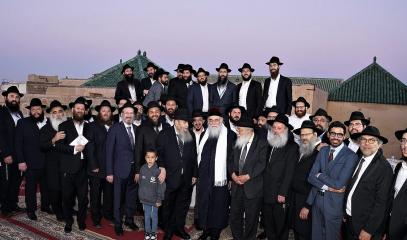Zvi Kogan and Chabad Judaism: messianism in 100 countries
The Moldovan-Israeli rabbi killed in Dubai was a member of a Hasidic group that, although not the largest, is known for its outreach. It boasts nearly 5,000 emissaries (shluchim) who run about 3,500 institutions, including Chabad houses. For Israeli activist, defining the rabbi’s death as an act of anti-Semitism is limiting. His movement is "very important", but with critical issues.
Jerusalem (AsiaNews) – The killing in the United Arab Emirates (UAE) of 28-year-old Israeli-Moldovan Rabbi Zvi Kogan, in a probable kidnapping attempt for which Israeli leaders accuse Iran (which the latter denies), has put the spotlight back on Chabad Lubavitch, a Hasidic movement, which today boasts a global influence.
Born in Jerusalem, Rabbi Kogan moved to Abu Dhabi in 2020 in the aftermath of the Abraham Accords signed under US mediation. He was married to Rivky (née Spielman), granddaughter of Rabbi Gavriel Holtzberg, assassinated in Mumbai in the attack on the Nariman Chabad House in 2008.
The victim’s body was found in Al Ain, a city near the border between the Emirates and Oman, although the place of death remains uncertain.
Together with his wife, he ran a kosher grocery store in Dubai (Rimon), the target of online protests by pro-Palestinian and anti-Israeli netizens in the recent past.
“This murder must be placed in the context of war". Defining it as an "anti-Semitic attack" is the clear mirror of a "lack of knowledge of what is happening in the world, also because many Israelis have a very limited vision and narrative,” said Hana Bendcowsky speaking to AsiaNews.
An expert in interreligious dialogue, she is the director of the Jerusalem Center for Jewish-Christian Relations (JCJC R) at the Rossing Center for Education and Dialogue.
Rabbi Zvi Kogan’s death and its implications must be contextualised as part of the events of the last year in Gaza (and Lebanon). “Those who speak of an anti-Semitic attack show a detachment from reality and motivations, which are more complex,” she explained.
His death, in addition to casting a shadow on a possible involvement by Iran in a kidnapping attempt that went tragically wrong for the hostage, raises the visibility of Chabad, a Jewish Orthodox movement based in the United States, but with branches all over the world.
Also known as Lubavitch, after the Russian city where it was based for much of the 19th century, while not the largest Hasidic group numerically, it is by far the best known and most visible, in particular for its outreach towards Jews to bring them back to the faith.
The movement is the only Hassidic group using modern technologies and communication tools to spread the message and assert its global presence. From Memphis and Mumbai to Bangkok and Boston, there is hardly any major city on the planet that does not have a permanent Chabad presence.
For Hana Bendcowsky, “It is a very important group for several reasons: it encourages more Jews to practise the Torah, it promotes messianic idealism, and it also provides concrete support so that Judaism can be practised, from kosher food to Shabbat, leading Jews to perform good deeds as well.
“In almost every corner of the world there is a home, which becomes a more accessible [source of] support than consulates and embassies, a less bureaucratic place to ask for help.” Yet, there is also a downside, the very "material" outreach requires “everyone must be religious; they do not admit secularism among Jews, who must practise."
One of the primary purposes of Chaba’s mission is to convince fellow Jews to "follow the seven universal laws" because this is what the Talmud teaches them.
Chabad's influence is largely the product of the efforts of nearly 5,000 shluchim, or emissaries who run some 3,500 institutions in 100 countries. Typically, the shluchim are a married couple who live and run a Chabad house, providing meals, classes, prayer services, and (depending on location) tourist support.
In some countries, Chabad is the only organised Jewish presence. The group is also highly visible on the Internet and operates chabad.org (among other websites), which claims to have 52 million visitors a year.
Added to this, it has one of the largest Orthodox publishing houses in the United States, an international group of young people, and a worldwide network of yeshivas.
Chabad was founded in 1775 by Rabbi Shneur Zalman of Liadi (also known as Der Alter Rebbe, The Older Rabbi) in Lyady, present-day Belarus. Shneur Zalman was a disciple of Dov Ber of Mezeritch (also known as Magghid of Mezeritch), who in turn was the main disciple of the Ba'al Shem Tov, founder of the Hasidic movement.
Zalman was considered a prodigy, so much so that according to the chronicles he earned the title of rabbi at the age of 12.
The name Chabad is an acronym, coined by Zalman, which stands for the three components of the intellect: chochmah (wisdom), binah (understanding) and da'at (knowledge).
While Hasidism emerged as a reaction to what was seen as an overly erudite, yeshiva-centric form of Judaism, Shneur Zalman taught that the heart must remain subordinate to the mind.
But it was thanks to Menachem Mendel Schneerson that the movement morphed from an isolated Hasidic sect into the highly influential Jewish force it is today.
Born in 1902 in present-day Ukraine and universally referred to by his followers simply as "Der Rebbe" (The Rabbi), he was considered a gifted scholar from a young age.
Schneerson saw in the high rates of intermarriage and assimilation of Jews a kind of spiritual Holocaust. According to his teachings, bringing Jews closer to their heritage and to observing the biblical commandments would hasten the coming of the Messiah.
His efforts focused on Jews, but were not limited to them. Schneerson also asked his followers to encourage everyone to observe the seven "universal" laws (Noahide laws, or laws of Noah), the universal moral obligations that Judaism teaches are incumbent on all humanity.
Der Rebbe died childless, without designating a successor, leaving the movement without a leader but remained its "guiding light" today. In the decades after his death, Chabad's expansion around the world has continued at a rapid pace.
Between 1994 and 2002, more than 610 new emissaries were sent and 705 new institutions were opened, journalist Sue Fishkoff wrote in her book The Rebbe's Army.
In that same period, Chabad's presence in the former Soviet bloc increased from eight Russian cities to 61 across the region.
Chabad operates not only in large urban areas, but also in towns and rural areas. In some places it caters primarily to the needs of Jewish travellers, offering to the world the face of modern Judaism.








.png)










